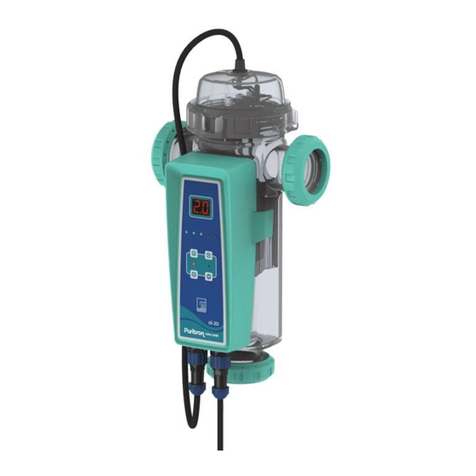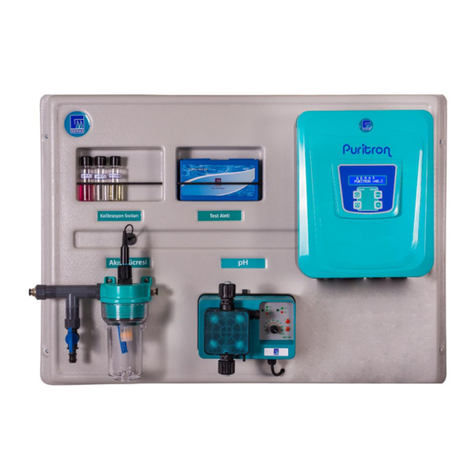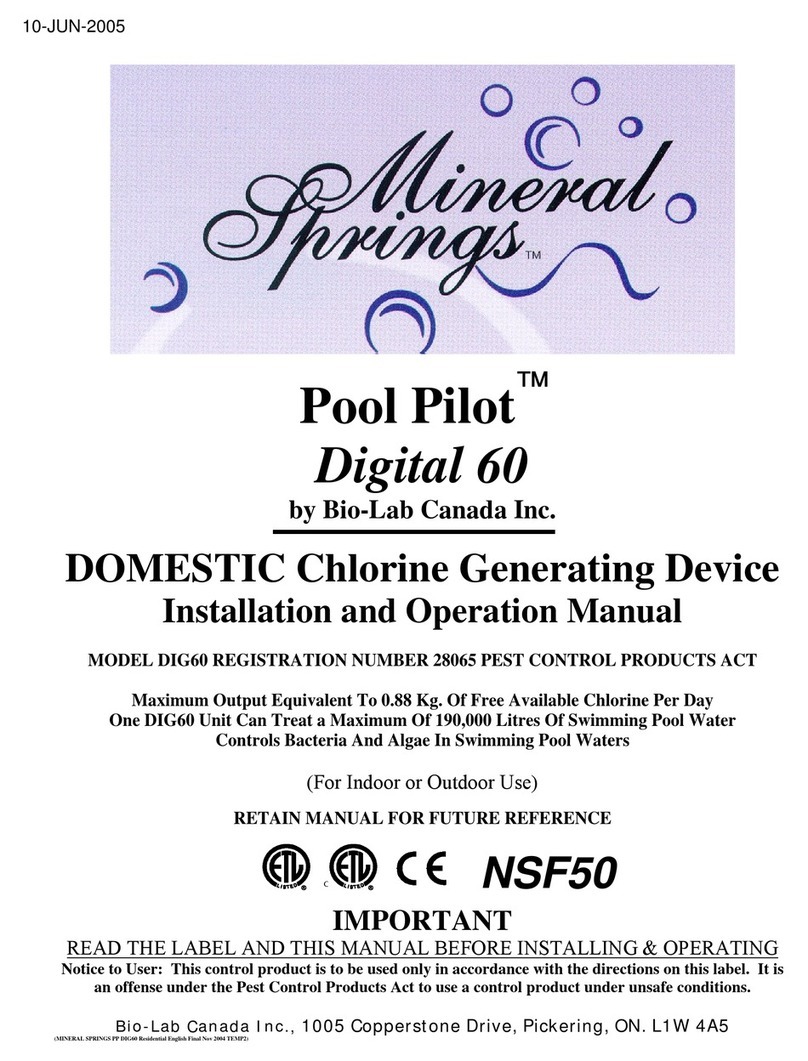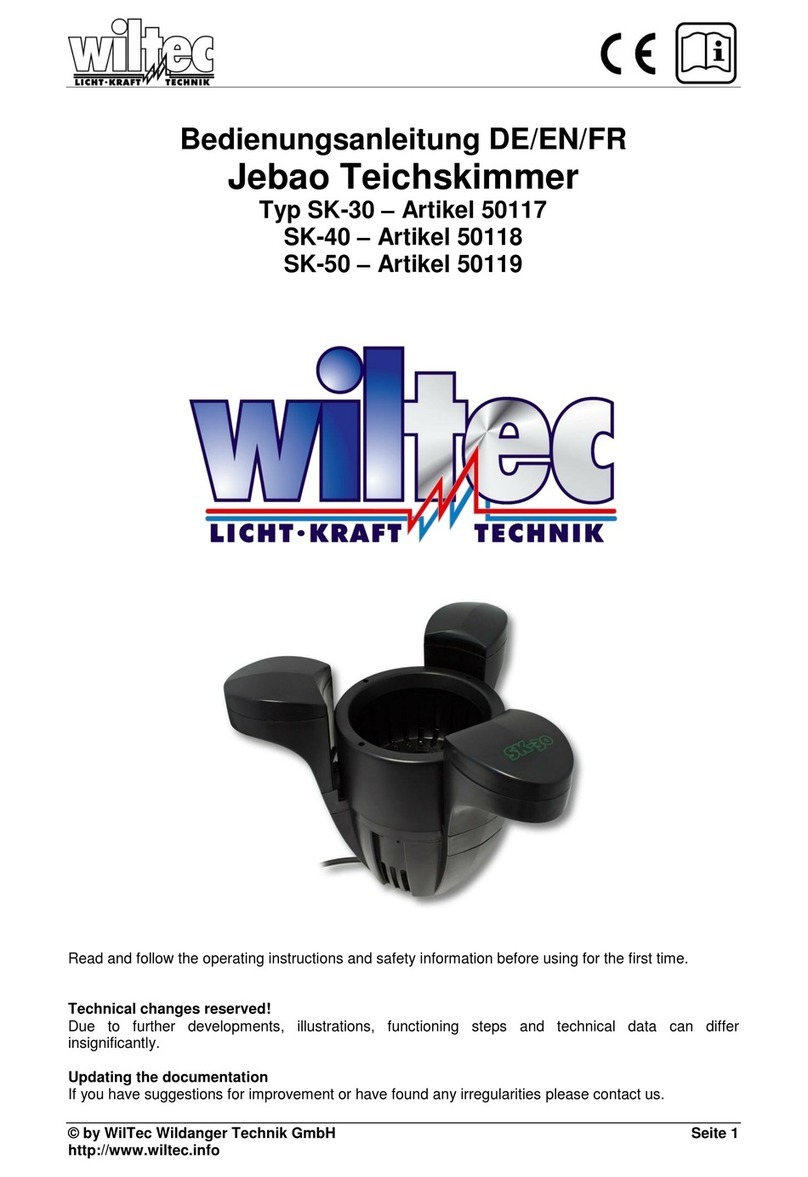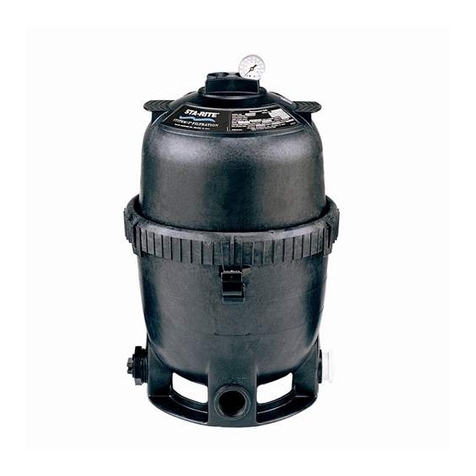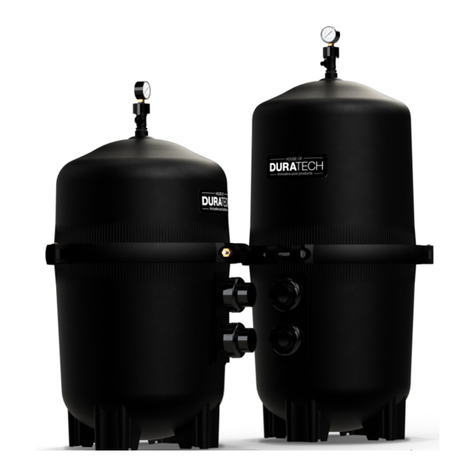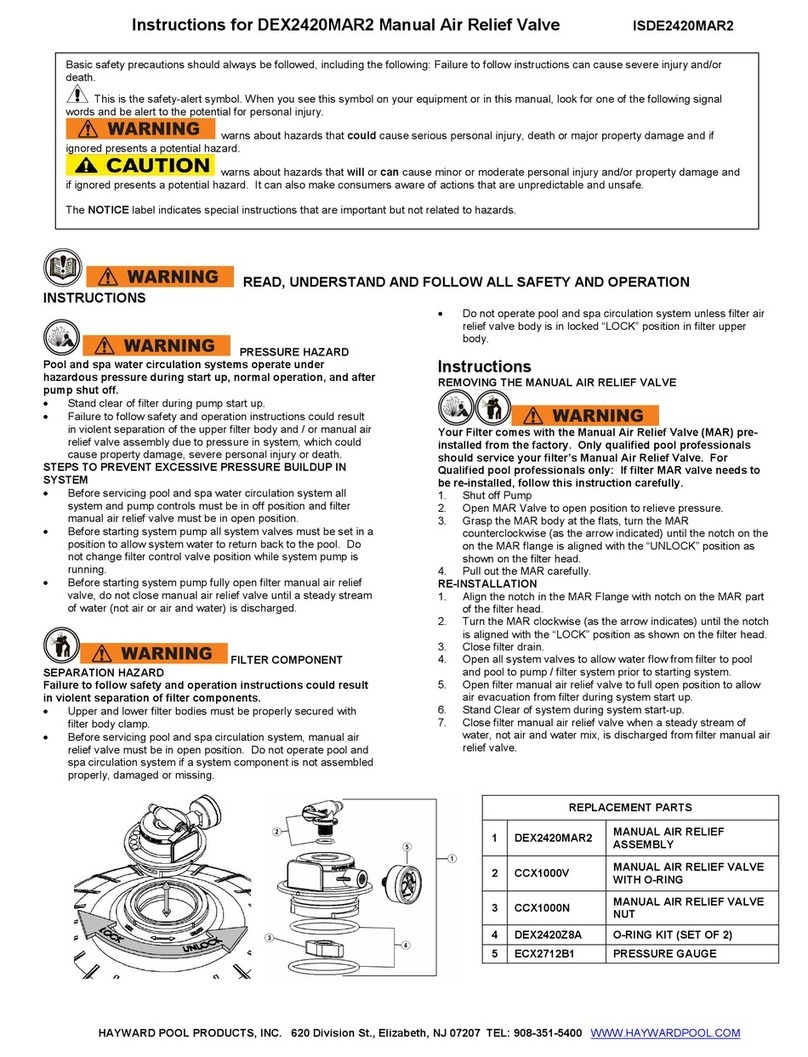Gemas BOBBIN WOUND User manual

HORIZONTAL FILTERS INSTALLATION MANUAL
BOBBIN WOUND SAND FILTERS FOR AQUATIC APPLICATION
IMPORTANT SAFETY INSTRUCTIONS
READ AND FOLLOW ALL INSTRUCTIONS
SAVE THESE INSTRUCTIONS

Declaration of Conformity
We declare, under our sole responibility, that the product identified, and to
which this declaration relates, are in conformity with the protection
requirements of Council Directive 97/23/EC.
The manufacturer, Gemas has the right to modify the products without previous
notice for as far as their characteristics are not really changed by this.
All rights reserved. This document is subject to change without notice.
Warranty conditions: 2 years limited warranty
IMPORTANT SAFETY INSTRUCTIONS
THESE OPERATING INSTRUCTIONS CONTAIN IMPORTANT INFORMATION
ON THE SAFE, PROPER AND ECONOMICAL OPERATION OF THIS SWIMMING POOL
APPLIANCE. STRICT OBSERVATION OF THE OPERATING INSTRUCTIONS WILL HELP
TO AVOID DANGERS, REDUCE REPAIR COSTS, SHUTDOWN TIMES AND INCREASE
THE RELIABILITY AND WORKING LIFE OF THE PRODUCT.

Water Inlet
Water Outlet
Collector
Inside Set
Support
Filter Candles
Manhole
Collector
Drainage
BOBBIN WOUND
SAND FILTERS
1- GENERAL INFORMATION
1.1- INSTRUCTION
This manual provides the necessary instructions to
install, use and maintain bobbin wound filters. In order
to obtain the benefits that are indicated in the
characteristics, all the instructions that appear in this
manual must be followed. This will offer a safe and long-
lasting installation.
The equipment’s supplier will provide further
information to the user whenever it is needed.
2- DESCRIPTION
2.1 Description
These filters have been designed to provide water in
pools and aquatic parks, also for all water treatments
that require the elimination of suspended matter using
the proper reduction of filtration element.
Apart from the filter itself, filtration and purification
process include some points that must be taken into
consideration as they can influence the correct filter
operation. These would be chemical water treatment,
pump equipment, pipe segments and general hydraulic
design.
When public pools are concerned, the current rules in
each country should be observed, as the installation
must follow them.
The filtration quality depends on different parameters as
depth of filtration bed, characteristics, quality and grade
of filtration media, etc., as well as filtration rate.
2.2 Filter’s Characteristics.
The tank is made of resin of polyester and fiberglass,
totally anticorrosive. Inside, it contains collectors and
diffusers made of unalterable plastic material (PVC and
ABS), tested against salt-water. They are supplied for a
working pressure of 2.5 kg/cm2, 4 kg/cm2, or 6 kg/cm2
and a maximum temperature of 50ºC. Other
specifications can be supplied upon request.
Filtration rates may be 20, 30, 40 and 50 m3/h/m2,
depending on the application and the kind of filtration
elements that have been selected. Rate 50 is not
recommended in public pools.
3. HANDLING & INSTALLATION
3.1 Handling
Filters must be lifted up with a strong steel cord through
the eyebolts as shown in below diagram.
DO NOT LIFT UP FILTER FROM BOTTOM OF FILTER
BODY AND DO NOT USE FORK LIFT. FILTER MUST BE
LIFTED UP WITH CRANE FROM EYEBOLTS.
3.1.1-Filters location.
Filters must be placed under the water level. However if
vacuum occurs in the installation, suction cups must be
installed in the lids to avoid that depression could
collapse the filter’s tanks.
Filters must be situated so that their bases are perfectly
level and completely supported by the floor.
Eyebolts
Airpurge
Diffusers

The location must have the proper space to allow
maintenance periodic overhauls and any other work.
Additionally the room must provide a drain to allow, in
case of accident, evacuation of water flowing from any
tube, filter, pump, etc. this will avoid risk of damages in
the electrical installations (pump, electric panels, etc.)
3.2 Filter Installation
Filters are delivered properly packed and ready in order
to facilitate unloading and transport using crane. It is
very important to make sure that the filters have not
suffered bumps during transport. Each package has a
number label which corresponds with the pair of the
stack set.
To obtain a correct filter installation, the following
stages must be observed:
-Install bottom filter on their final location. Make Sure
that the floor is leveled and all legs stand properly on the
floor.
-Put upper filter onto bottom filter as shown on photo.
Please carry the filters as intructed on 3.1 Handling of
this manual.
DO NOT PUT UPPER FILTER ONTO BOTTOM FILTER IF
BOTTOM FILTER IS NOT FILLED UP.
- Make Sure the holes of the legs correspond to each
other as shown on below photo.
-Fix filters to each other with screws and nuts on every
bases.
-Install correctly the valve battery(ies) in the filters.
-Install battery supports and regulate them correctly
(height, etc.).
-Connect batteries with the delivery pipe of the pumps,
returns pipes and drain.
-Before filling, Check that the inner parts of each filter
(nozzles, collectors, top, diffusers) are in good condition
-First, fill minimum 1/3 of the bottom tank with water.
AFterwards, fill the bottom tank with gravel (1-3 mm )
and fine quartz sand. The filling must be made according
to the “SAND LEVEL” lavels on the filters
-After the filling of the bottom tank, apply the same
filling sequence to the upper tank.
ALL GEMAS FILTERS ARE HYDRAULIC TESTED AT
PRODUCTION FACILITY. NEVERTHELESS, IT IS ADVISED
TO FILL THE TANKS WITH WATER AND TEST THE
SYSTEM AT SITE, BEFORE FILLING WITH MEDIA. THIS IS
A PRECAUTION TO OBSERVE ANY DAMAGES DUE TO
HANDLING, TRANSPORT ETC.
ATTENTION!
ALWAYS FINALIZE THE FIXATION OF THE BATTERY AND
PIPE SUPPORTS AFTER THE FILTER IS FILLED WITH
WATER. OTHERWISE, WEIGHT OF THE FILLED WATER
MAY CAUSE LEAKAGE.

3.1.2 Setting up the valve battery.
Valves battery is delivered completely equipped, with
four or five valves, (depending on your order), and its
manometer panel with its corresponding connections.
Filters connections may be flange polyester outlets of
Ø200 up to Ø250 or with PVC outlets of Ø63 up Ø160.
Check the filters if they are situated in the suitable
distance from batteries and that they are lined-up.
You can start placing the battery avoiding forcing the
flanges. Check also that outlets have not been damaged
and that they are completely clean and empty.
3.1.3 Manometers.
On pool filters, when the filter is clean, the usual
pressures are:
-Inlet pressure: 0.8-1 Kg/cm2
-Outlet pressure: 0.4-0.6 Kg/cm2
When the differential pressure between the two
manometers is 1 Kg/cm2 or higher, backwash must be
carried out.
NOTE: Once the manometers have been installed, you
should cut the two little caps that are placed in the
backside of the panel.
These caps have been put there to avoid the spilling of
the manometer’s glycerin.

3.1.4-Battery installation.
Once the battery is perfectly lined-
up, it is necessary to install special
supports to hold up the weight of the
battery and the water that follows in
it.
When the proper level and height
have been achieved, the screw that
supports the clamp must be
tightened using a spanner.
In order to avoid that pulses and
vibrations could damage or break the
batteries when the tubes are being
installed, other kind of supports are
also available.
IMPORTANT NOTE:
Avoid the fixing system that blocks
the normal dilation of materials.
If you have any doubt,
4- STARTING
Before filling filters sand or other filtration elements, it is
advisable to check the internal collectors to make sure
that they have not been damaged during transport or
installation. Afterwards, fill the filters and the water
installation and make an hydraulic test. Thus, you will
make sure that there is no leak and that equipment
works properly.
Then stop the pumps, open each filter’s lid (the filter
must not be emptied without opening the lid, as it could
collapse) and empty half the water that each filters
contains.
Then, start filling the filter with sand or other filtration
elements, taking into account that first of all you must
put gravel up to the collector arms (10 cm. approx).
This must be done very carefully in order to avoid any
damage in the lower components of the filter. When the
filter is being filled with sand, this must be carefully
spread over the surface.
Once the filter is full with the filtration elements clean
the lid and the inner part of the manhole. This will
prevent any debris and particles of sand affecting the
seal of the joint. PLease follw the filling order of the
bottom filter first, and top filter second for dual stack
filters.
No
Description
1
Filter lid
2
Filter lid gasket
3
Air purge
4
Air purge o-ring
5
Screw cap
6
Inox Nut
7
Washer Inox
Put the seal in the lid; then introduce the lid in the
manhole, screws must be possitioned according to screw
gaps on the lid to fix with nuts, leaving it leveled and
centered.
Washers and nuts must be put on screws and tightened.
1
2
3
4
5
6
7

5-WORKING PROCESS
5.1-Filtration.
It has to be done with the pump stopped and valves in
position Fig 13.
During the filter functioning it is recommended to
observe periodically the inlet and outlet manometers;
the filtration element must be washed when the
pressure difference between the two manometers is
from 0.8 to 1 Kg/cm2.
You can also install an automatic saturation alarm that
will warn when the filter has achieved the selected
pressure.
5.2-Backwash.
The filtration bed forms thousands of channels that
collect the impurities and solid waste contained in
water.
In the course of time, sediment may block the collector
system and dirt may blind the filter medium. In order to
clean the filter, backwash must be carried out. Stop the
pump and put valves in position, Fig 14.
The length of backwash will depended on the filtration
element selected, but according to DIN 19643 the length
should be 7 minutes, working on a rate of 50 m3/h/m2
approximately.
It is advisable to put a sight glass in the overflow tube to
check the length of backwash.

5.3 Rinse.
This process can only be done when a five valve battery
has been installed.
Rinse must be carried out immediately after backwash to
discharge the remaining impurities that could have
entered in the collectors during the filter’s backwash.
The length of rinse is 3 minutes (according to DIN
19643); this will prevent impurities appearing again in
the network. To perform rinse, valves must be in
position Fig. 15. Keeping the pump stopped; after this,
they must be immediately returned to position of
filtration.
5.4-Drain.
When the pool has to be emptied, if its drain does not
contain an overflow directly linked to the sewer, it can
be drained using the filter’s pump and putting valves in
position. Fig. 16.
Before starting draining, it is necessary to check that the
skimmer’s valves, overflow channel and vacuum cleaners
are closed.
5.5-Closed.
It is used to perform maintenance on the filter, clean
prefilters, etc. As its name shows, all valves must be
closed.

6- EMPTYING OF FILTERS SAND
To change sand or filtration media, proceed as follows:
1-Remove top lid.
2-Drain filter’s water through the lower drainage hole.
3- Always Start Emptying yje filter from the TOP
filters for Dual Stack Filters
4-If there is enough clear space, sand can be removed
though the man hole. It can also be removed unscrewing
the lower drainage hole.
4-To refill the filter with sand, follow the instructions
given in starting, checking first of all that the drainage
hole has been perfectly fitted and that it does not leak
water.
7- OTHER RECOMMENDATIONS
-If the equipment has been stopped during a long period
of time, it is recommended to empty the water filter.
-If the filter is situated outside, it is recommended to
paint it with a suitable product every two years.
-In standard filters, ozone water treatments must not be
used and pressure and temperature specifications not be
exceeded. Contact our technical department if you have
any doubt about the use of our filters.
-During the washing process, pressure must never
exceed 1 Kg/cm2 for filters with plate with nozzles.
-Optionally, high performance filters can also be
delivered with lateral man hole and sight glass, as well as
special inner finishes of high maintenance quality and
chemical resistance.
8- GUARANTEE
This filter has been manufactured using the best high
technology materials and manufacturing process, going
through strict quality test on materials, finishes and
performance. All those bumps, rips and breakages
caused by an inadequate use of the product or by
ignoring our recommendations are not included in this
guarantee.
The correct performance of the filter is guaranteed for 2
years.
This guarantee only covers the replacement or repair of
defective spare parts in our factory. Extra charges like
works made by third parties, compensations, etc… will
not be accepted by the manufacturer.
BOBIN WOUND SAND FILTERS NOTES
Table of contents
Other Gemas Swimming Pool Filter manuals
Popular Swimming Pool Filter manuals by other brands

poolstar
poolstar POOLEX Sel-In user guide
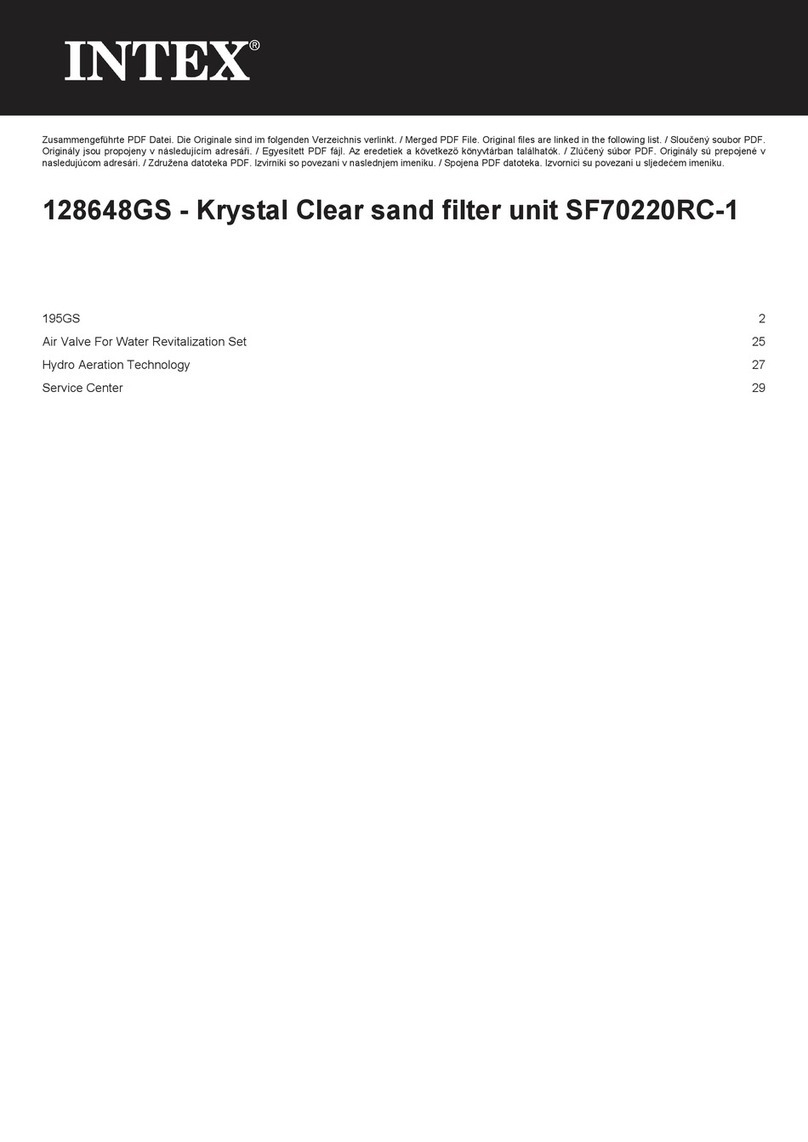
Intex
Intex SF70220RC-1 owner's manual
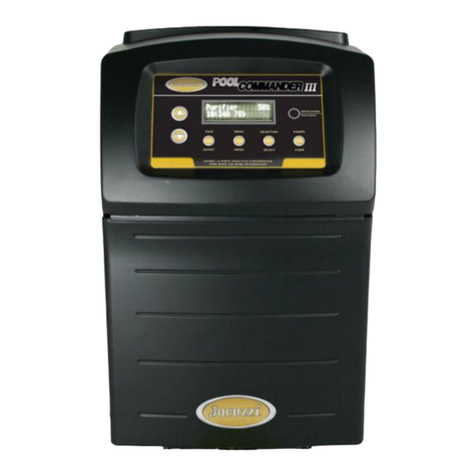
Jacuzzi
Jacuzzi COMMANDER III JC7 Installation and operation manual
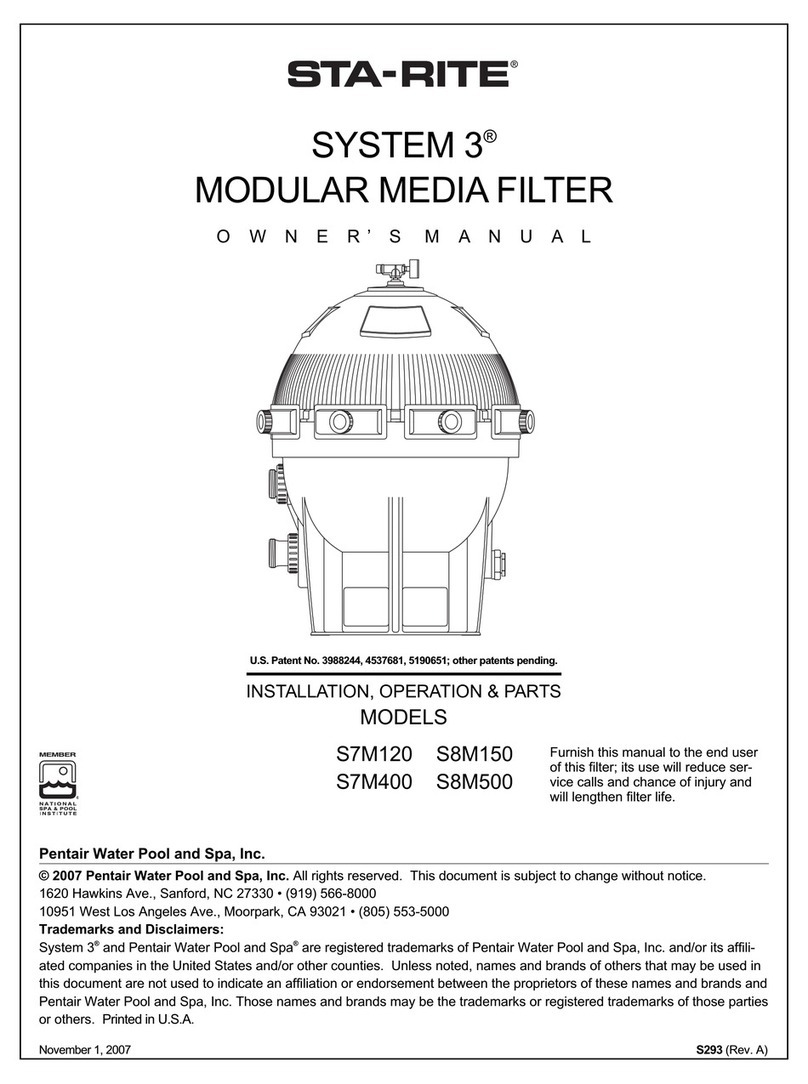
STA-RITE
STA-RITE System 3 owner's manual
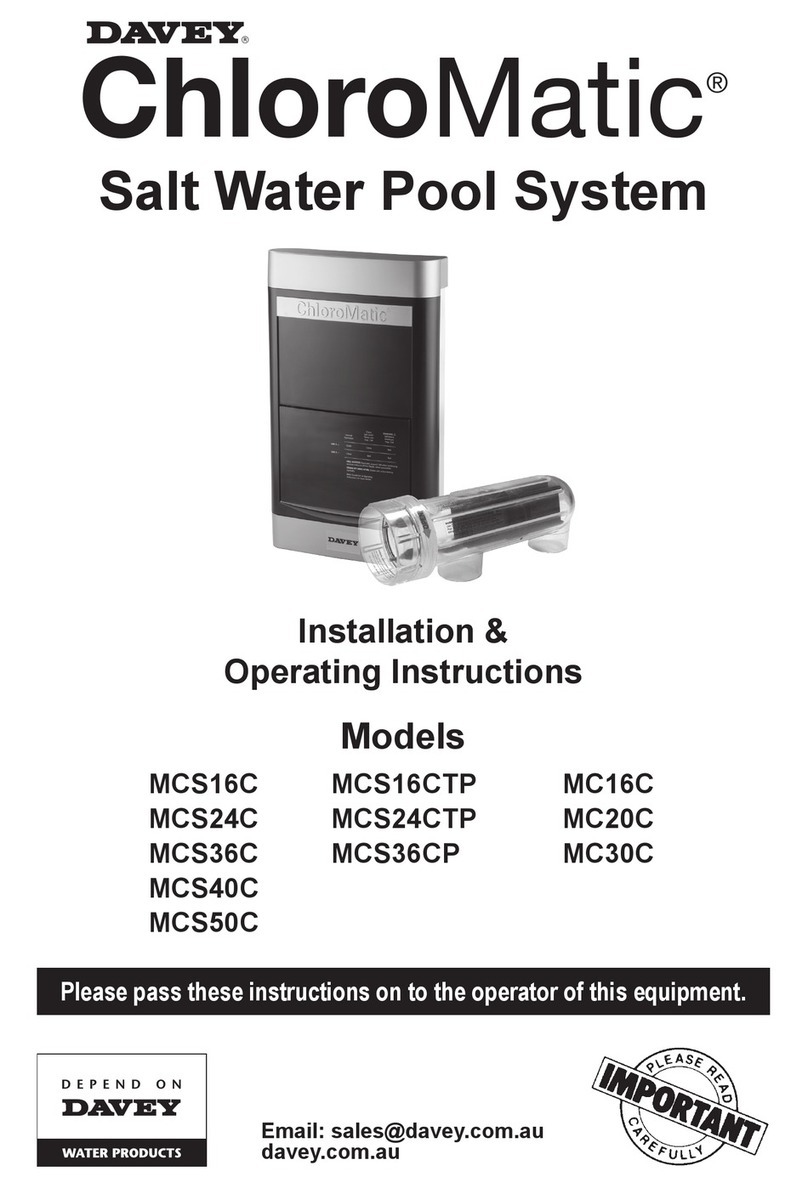
Davey
Davey ChloroMatic MCS16C Installation & operating instructions
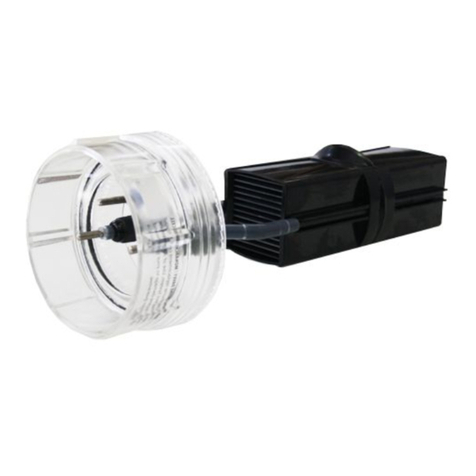
Monarch Industries
Monarch Industries Chloromatic ESR Series owner's manual
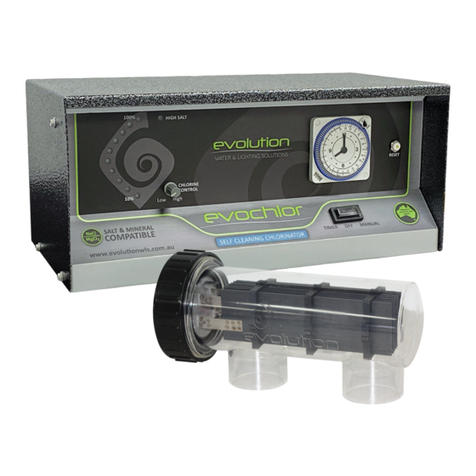
Evolution
Evolution A15TS Installation & operation manual
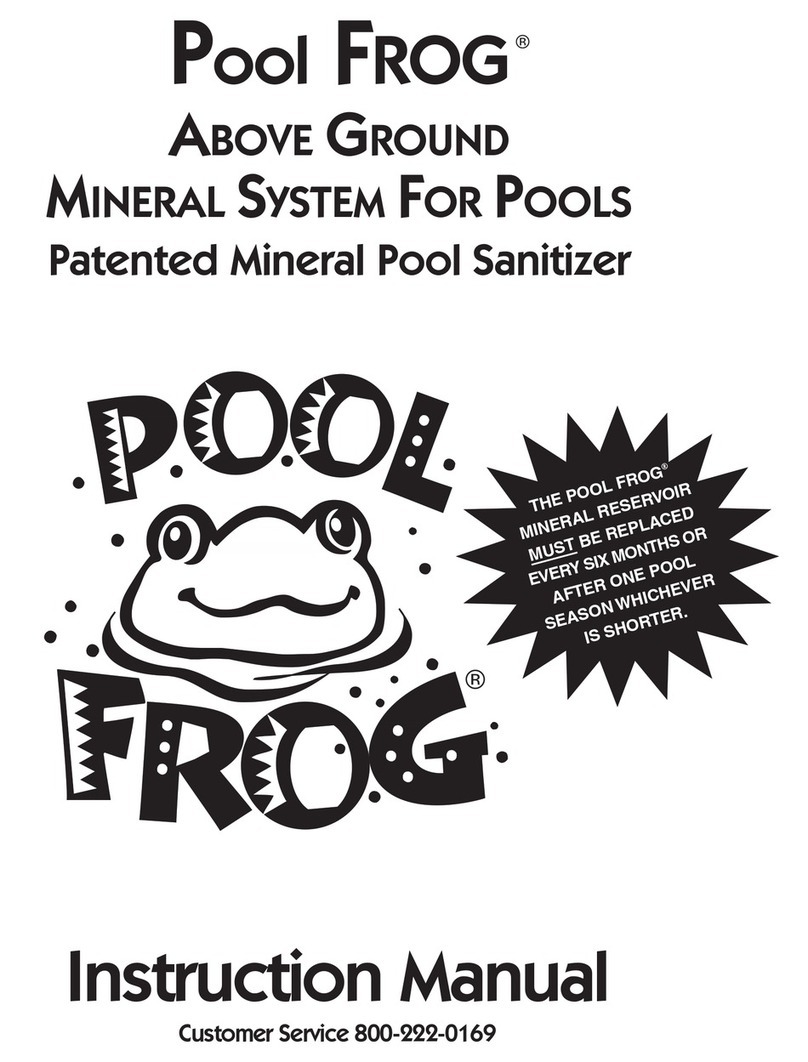
Pool Frog
Pool Frog ABOVE GROUND MINERAL SYSTEM FOR POOLS instruction manual
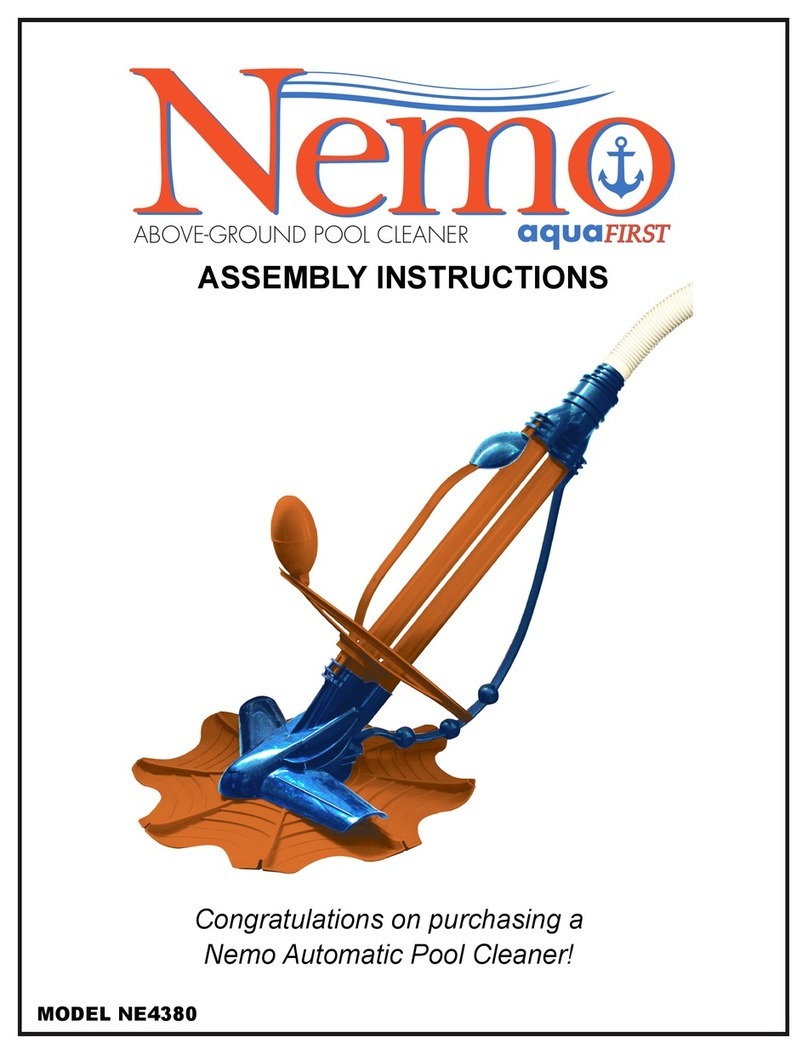
Nemo
Nemo NE4380 Assembly instructions
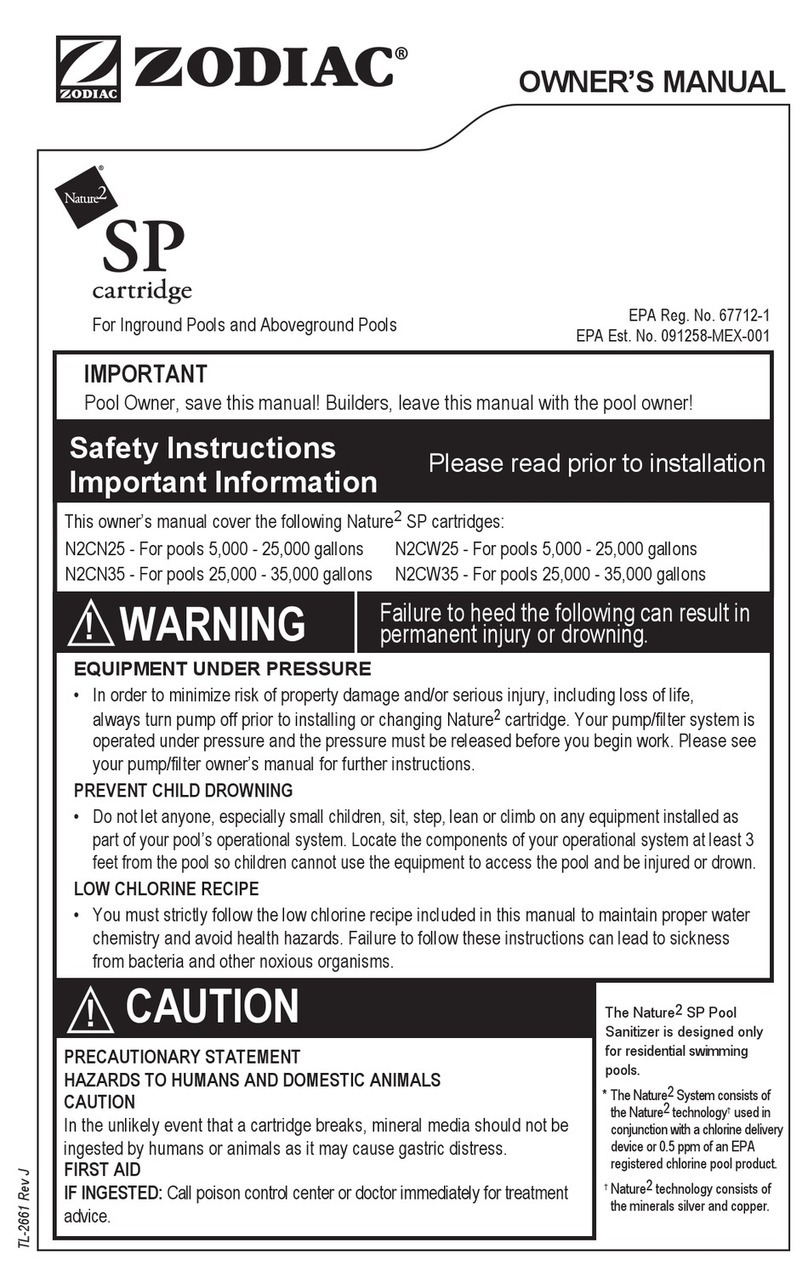
Zodiac
Zodiac Nature2 N2CN25 owner's manual
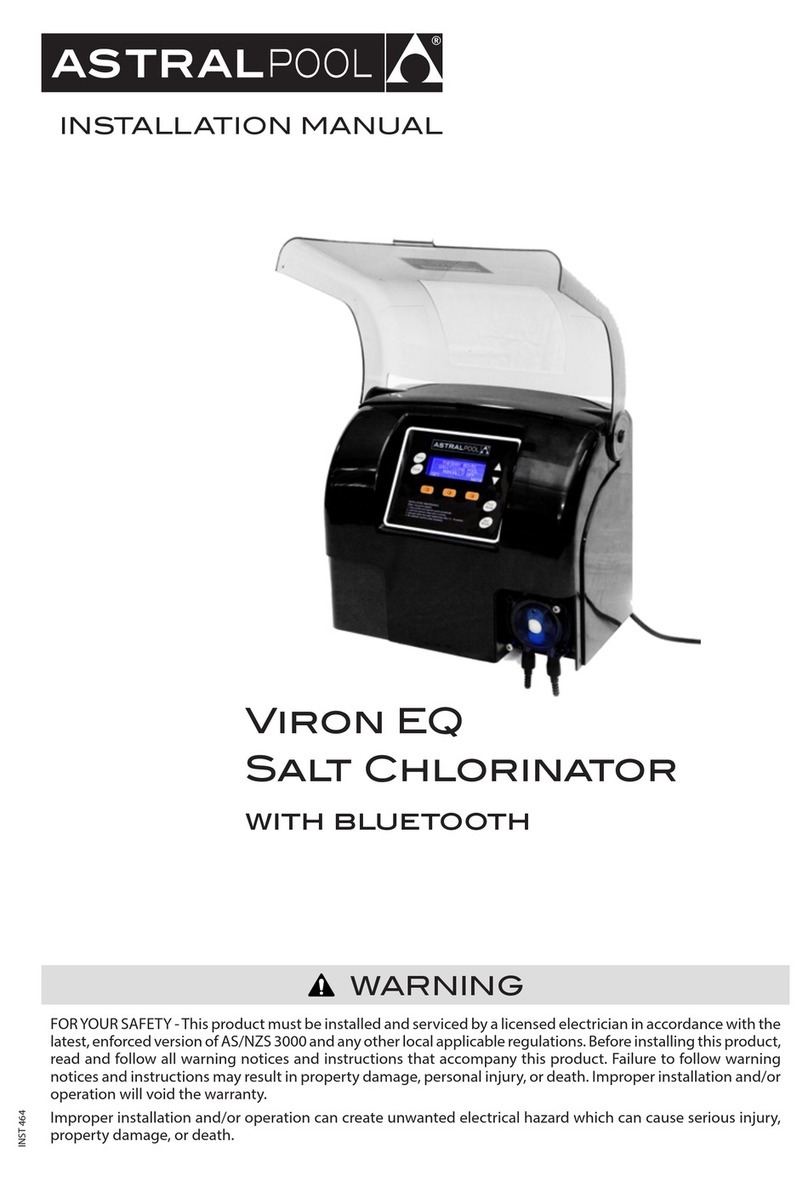
Astral Pool
Astral Pool Viron EQ installation manual

Orphek
Orphek HELIX 5000 installation guide
